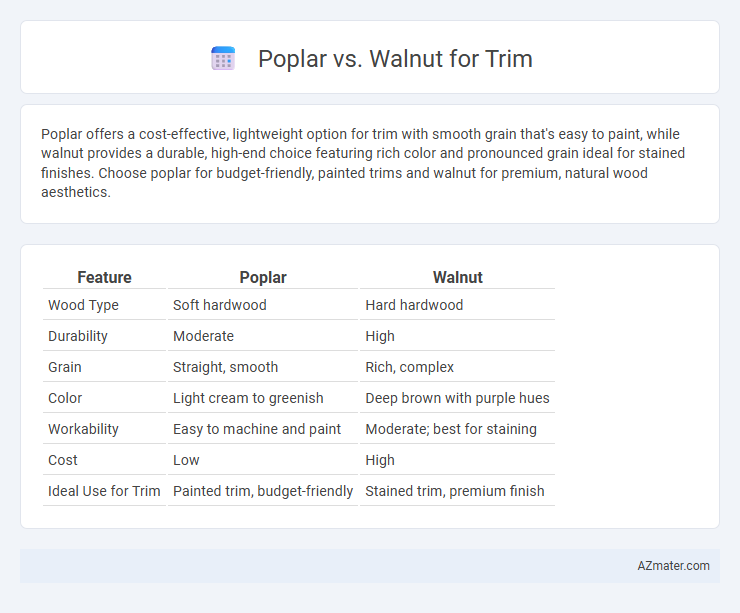Poplar offers a cost-effective, lightweight option for trim with smooth grain that's easy to paint, while walnut provides a durable, high-end choice featuring rich color and pronounced grain ideal for stained finishes. Choose poplar for budget-friendly, painted trims and walnut for premium, natural wood aesthetics.
Table of Comparison
| Feature | Poplar | Walnut |
|---|---|---|
| Wood Type | Soft hardwood | Hard hardwood |
| Durability | Moderate | High |
| Grain | Straight, smooth | Rich, complex |
| Color | Light cream to greenish | Deep brown with purple hues |
| Workability | Easy to machine and paint | Moderate; best for staining |
| Cost | Low | High |
| Ideal Use for Trim | Painted trim, budget-friendly | Stained trim, premium finish |
Introduction: Poplar vs Walnut for Trim
Poplar and walnut are popular wood choices for trim, each offering distinct characteristics that influence design and functionality. Poplar is a cost-effective, lightweight wood with a smooth grain, making it ideal for painted trim and easy customization. Walnut, known for its rich, dark color and durability, provides a luxurious finish but comes at a higher price, suited for high-end interior accents.
Appearance and Grain: Poplar vs Walnut
Poplar trim exhibits a light, creamy color with subtle, straight grain patterns, offering a smooth and uniform appearance ideal for painted finishes. Walnut trim features rich, deep brown tones with pronounced grain variations, including waves and curls, delivering a luxurious and natural aesthetic that stands out in stained or clear-coated applications. Choosing between poplar and walnut for trim depends on whether a soft, neutral backdrop or a striking, warm wood texture better complements the interior design.
Color Differences in Poplar and Walnut Trim
Poplar trim features a light cream to pale yellow color with subtle green or brownish streaks, offering a neutral base ideal for painting or staining. Walnut trim displays rich, deep brown tones with natural purple or gray undertones that enhance its elegant and luxurious appearance. Choosing between Poplar and Walnut trim depends on the desired color aesthetic, where Poplar provides versatility for custom finishes and Walnut delivers a distinctive, dark woodgrain beauty.
Durability and Hardness Comparison
Walnut offers superior durability and hardness compared to poplar, making it a preferred choice for trim in high-traffic areas. With a Janka hardness rating of approximately 1,010, walnut resists dents and scratches well, while poplar, rated around 540, is softer and more prone to wear over time. The enhanced strength and dense grain of walnut provide longer-lasting trim that maintains its appearance under heavy use.
Workability: Ease of Cutting and Shaping
Poplar offers superior workability for trim due to its softer texture, making it easier to cut and shape with standard woodworking tools. Walnut, while denser and harder, requires sharper blades and more effort but provides a smoother finish and greater durability. Choosing poplar simplifies intricate detailing and faster project completion, whereas walnut delivers a premium, long-lasting trim solution.
Finishing and Staining Results
Poplar wood offers a smooth, even grain that accepts paint and stain well but tends to produce a blotchy finish without proper pre-treatment, making it ideal for painted trim or stained with a conditioner. Walnut features a rich, dark brown hue with natural color variation and grain patterns that enhance stain depth and contrast, resulting in a luxurious, high-end finish for trim work. When staining trim, walnut requires less preparation due to its inherent color, while poplar's lighter tone demands careful sanding and pre-stain treatment to achieve a uniform appearance.
Cost Differences: Poplar vs Walnut
Poplar trim is significantly more affordable than walnut, with prices typically ranging from $1 to $3 per linear foot for poplar compared to $6 to $12 per linear foot for walnut. The cost difference arises from poplar's faster growth rate and abundance, making it a budget-friendly choice for trim projects. Walnut's rich color, density, and premium quality drive higher prices, positioning it as a luxury option for high-end interior finishes.
Environmental Sustainability Considerations
Poplar wood, sourced from fast-growing, renewable trees, offers a more environmentally sustainable option for trim compared to walnut, which comes from slower-growing hardwood species with a higher ecological footprint. Using poplar reduces deforestation pressure and supports carbon sequestration through rapid regrowth cycles. Walnut trim, while prized for its rich aesthetics and durability, often involves more energy-intensive harvesting and longer forest recovery periods, impacting sustainable forest management goals.
Best Applications for Poplar and Walnut Trim
Poplar trim is ideal for painted applications due to its smooth texture and affordability, making it highly versatile for interior use such as baseboards and window casings. Walnut trim, prized for its rich, dark color and natural grain, is best suited for stained finishes in high-end interiors, cabinetry, and decorative moldings. Choosing walnut enhances luxurious spaces, while poplar offers cost-effective, durable solutions for extensive, painted trim projects.
Choosing the Right Wood for Your Trim Project
Poplar offers a smooth, paintable surface and affordability, making it ideal for trim projects requiring a crisp, clean finish without visible wood grain, while walnut provides rich color, natural grain patterns, and durability for high-end, natural wood appearances. Poplar's ease of machining and resistance to warping make it a practical choice for intricate moldings and painted interiors, whereas walnut's hardness and stability suit elegant, stained trims in upscale homes. Selecting between poplar and walnut depends on budget, desired finish, and whether the trim will be painted or left natural to highlight wood grain.

Infographic: Poplar vs Walnut for Trim
 azmater.com
azmater.com